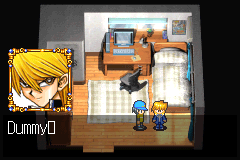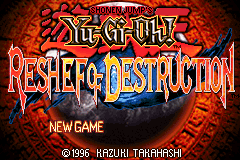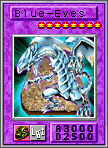Yu-Gi-Oh! Reshef of Destruction
| Yu-Gi-Oh! Reshef of Destruction |
|---|
|
Also known as: Yu-Gi-Oh! Duel Monsters 8: Reshef of Destruction (JP)
|
| To do: There's a debug mode, which sets Language to 0x06 (see below), gives the player 50 copies of every card, and probably other things as well. Find a GameShark code to activate it in-game. |
Yu-Gi-Oh! Reshef of Destruction is what happens when Konami listens to players complaining that Sacred Cards was too easy. Infamous for requiring the player to backtrack to the start of the game to sleep in order to recharge their lifepoints, a mechanic Konami themselves would later mock in two separate games.
Debug Text Function
Setting the language ID to 0x06 at RAM 0x2021CF8 skips every text box in the game. Note that the cards names have no data associated to the language ID 0x06, so you have to modify it to a value between 0x00 and 0x04 before starting a duel.
Dummy Dialog
 Two dummy text boxes are present at offsets 0xE78434 and 0xF13ED0.
Two dummy text boxes are present at offsets 0xE78434 and 0xF13ED0.
Unused Card Color
As in Yu-Gi-Oh! Dark Duel Stories, the color ID 02 is not used by any card in the game. It was most likely supposed to be used for Fusion Monsters, but they decided to make all Fusion Monster cards the Normal Monster card color instead. This is most likely because a couple of them have new effects and use the Effect Card color.
Unused Translations
Even though the US version doesn't have a language selection menu; every dialog, menu, and card in the game is translated in French, German, Italian and Spanish in the US ROM. The only thing missing is location names, as only the first location, Clock Tower Square, is translated, meaning the European localization was not entirely finished at that point.
Most menus from the Japanese version are still present, but they are not displayed properly in-game, as the necessary font is no longer present.
The Yu-Gi-Oh! series
| |
|---|---|
| Game Boy (Color) | Duel Monsters • Duel Monsters II: Dark Duel Stories • Monster Capsule GB • Dark Duel Stories (Localization Prototypes) • Duel Monsters 4: Battle of Great Duelist |
| Game Boy Advance | Dungeon Dice Monsters • The Eternal Duelist Soul • Worldwide Edition: Stairway to the Destined Duel • The Sacred Cards • Reshef of Destruction • Ultimate Masters: World Championship Tournament 2006 |
| PlayStation | Forbidden Memories |
| PlayStation 2 | The Duelists of the Roses • Capsule Monster Coliseum • GX: The Beginning of Destiny |
| Android, iOS, Windows | Duel Links |
| Nintendo 3DS | Yu-Gi-Oh! Zexal: World Duel Carnival |
- Pages missing developer references
- Games developed by Konami Computer Entertainment Japan
- Pages missing publisher references
- Games published by Konami
- Game Boy Advance games
- Pages missing date references
- Games released in 2003
- Games released in March
- Games released on March 20
- Games with unused code
- Games with unused text
- Games with debugging functions
- Pages with a Data Crystal link
- To do
- Yu-Gi-Oh! series
Cleanup > Pages missing date references
Cleanup > Pages missing developer references
Cleanup > Pages missing publisher references
Cleanup > To do
Games > Games by content > Games with debugging functions
Games > Games by content > Games with unused code
Games > Games by content > Games with unused text
Games > Games by content > Pages with a Data Crystal link
Games > Games by developer > Games developed by Konami > Games developed by Konami Computer Entertainment Japan
Games > Games by platform > Game Boy Advance games
Games > Games by publisher > Games published by Konami
Games > Games by release date > Games released in 2003
Games > Games by release date > Games released in March
Games > Games by release date > Games released in March > Games released on March 20
Games > Games by series > Yu-Gi-Oh! series

